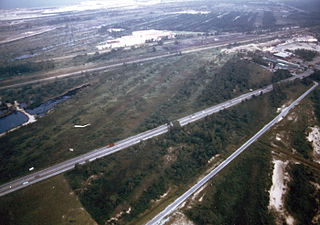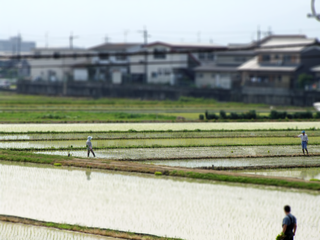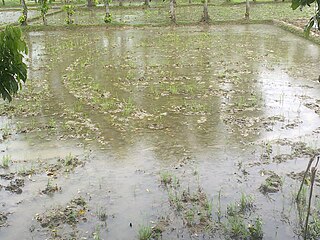
Land use involves the management and modification of natural environment or wilderness into built environment such as settlements and semi-natural habitats such as arable fields, pastures, and managed woods. It also has been defined as "the total of arrangements, activities, and inputs that people undertake in a certain land cover type."
In the United States, a conservation easement is a power invested in a qualified private land conservation organization or government to constrain, as to a specified land area, the exercise of rights otherwise held by a landowner so as to achieve certain conservation purposes. It is an interest in real property established by agreement between a landowner and land trust or unit of government. The conservation easement "runs with the land", meaning it is applicable to both present and future owners of the land. As with other real property interests, the grant of conservation easement is recorded in the local land records; the grant becomes a part of the chain of title for the property.

Agriculture, farming, and fishing form the primary sector of industry of the Japanese economy together with the Japanese mining industry, but together they account for only 1.3% of gross national product. Only 20% of Japan's land is suitable for cultivation, and the agricultural economy is highly subsidized.

Agriculture is a vital industry in China, employing over 300 million farmers. China ranks first in worldwide farm output, primarily producing rice, wheat, potatoes, tomato, sorghum, peanuts, tea, millet, barley, cotton, oilseed and soybeans.
Farmland preservation is a joint effort by non-governmental organizations and local governments to set aside and protect examples of a region's farmland for the use, education, and enjoyment of future generations. It is often a part of regional planning and national historic preservation.
Mexico, a classified arid and semi-arid country, has a total land area of 2 million square kilometres, 23% of which is equipped for irrigated agriculture. The agricultural sector plays an important role in the economic development of the country accounting for 8.4 of agricultural gross domestic product (GDP) and employing 23% of the economically active population. Irrigated agriculture contributes about 50% of the total value of agricultural production and accounts for about 70% of agriculture exports. Mexico’s government initiated a number of structural reforms in the water sector aimed to introduce modern water management and irrigation.
Development-supported agriculture
is a nascent movement in real estate development that preserves and invests in agricultural land use. As farmland is lost due to the challenging economics of farming and the pressures of the real estate industry, DSA attempts to reconcile the need for development with the need to preserve agricultural land. The overall goal of DSA is to incubate small-scale organic farms that co-exist with residential land development, providing benefits to farmers, residents, the local community, and the environment.
Agricultural law, sometimes referred to as Ag Law, deals with such legal issues as agricultural infrastructure, seed, water, fertilizer, pesticide use, agricultural finance, agricultural labour, agricultural marketing, agricultural insurance, farming rights, land tenure and tenancy system and law on Agricultural processing and rural industry. With implementation of modern technologies, issues including credit, intellectual property, trade and commerce related to agricultural products are dealt within the sphere of this law.
Transferable development rights (TDR) is a method for controlling land use to complement land-use planning and zoning for more effective urban growth management and land conservation. The TDR process can be considered a tool for controlling urban sprawl by concentrating development. TDR is a legal mechanism offered in some local government jurisdictions as a form of development control. TDR are also a way to avoid constitutional takings issues caused by rezoning areas that would otherwise eliminate a significant amount of value from the property. The procedure offers landowners financial incentives or bonuses for the conservation and maintenance of the environmental, heritage or agricultural values of their land. TDR is based on the concept that with land ownership comes the right of use of land, or land development. These land-based development rights can in some jurisdictions be used, unused, sold, or otherwise transferred by the owner of a parcel.

Agriculture in Saudi Arabia is focused on the export of dates, dairy products, eggs, fish, poultry, fruits, vegetables, and flowers to markets around the world as it has achieved self-sufficiency in the production of such products. The government of Saudi Arabia is heavily involved in the agriculture industry, and the ministry of agriculture is primarily responsible for the agricultural policies in the nation. The private sector also plays a role in the nation's agriculture, as the government offers long-term interest-free loans and low-cost water, fuel, electricity, and duty-free imports of raw materials and machinery. Still, Saudi Arabia is dependent on imports to meet 70% of its food requirements.

Right to farm laws in the United States deny nuisance lawsuits against farmers who use accepted and standard farming practices and have been in prior operation even if these practices harm or bother adjacent property owners or the general public. Agricultural nuisances may include noise, odors, visual clutter and dangerous structures. All 50 states have some form of Right to Farm law.

The Agricultural Reserve is a designated land use zone in Montgomery County, Maryland. The 93,000 acres (380 km2) zone was created in 1980 by the Montgomery County Council to preserve farm land and rural space in the northwestern part of the county. The farmland protection program has been characterized as "the most famous, most studied and most emulated" program of its kind in the United States.
Preservation development is a model of real-estate development that addresses farmland preservation. It shares many attributes with conservation development, with the addition of strategies for maintaining and operating productive agriculture and silviculture, often in perpetuity. A preservation development is a master planned community that allows limited, carefully designed development on a working farm, while placing the majority of productive land under a system of easements and community governance to ensure a continuity of farming and environmental stewardship.

Land grabbing is the contentious issue of large-scale land acquisitions: the buying or leasing of large pieces of land by domestic and transnational companies, governments, and individuals. While used broadly throughout history, land grabbing as used in the 21st century primarily refers to large-scale land acquisitions following the 2007–08 world food price crisis. Obtaining water resources is usually critical to the land acquisitions, so it has also led to an associated trend of water grabbing. By prompting food security fears within the developed world and new found economic opportunities for agricultural investors, the food price crisis caused a dramatic spike in large-scale agricultural investments, primarily foreign, in the Global South for the purpose of industrial food and biofuels production. Although hailed by investors, economists and some developing countries as a new pathway towards agricultural development, investment in land in the 21st century has been criticized by some non-governmental organizations and commentators as having a negative impact on local communities. International law is implicated when attempting to regulate these transactions.
Sustainable Water and Innovative Irrigation Management (SWIIM) is a farm-optimization and water-conservation system owned by SWIIM System, Ltd. that was developed by Regenesis Management Group, LLC., a Denver, Colorado-based incubator that focuses on natural resource conservation and optimization technology.

Agriculture played a major role in the early growth of Connecticut as one of the original 13 colonies that would form the United States of America, particularly in the Connecticut River valley which provided fertile soil, temperate climate and easy access to markets. As the Industrial Revolution helped focus capital on mercantile centers in the 19th century, Connecticut farmers over time ceded their relative economic and political influence.
Peak farmland is the maximum usable amount of land needed for crop cultivation for a given region. Supporters of the peak farmland theory argue that even with the growing world population, the need for more farmland is decreasing, as food production yields per acre of farmland are rising faster than the global demand for food. This is supported by the fact that the area dedicated to farmland in some countries, both developed and developing, has already begun to decline. Globally, while the total amount of arable land is still increasing, the area of permanent pasture has been in decline since 1998, with at least 60 million hectares no longer grazed. It is argued that other countries, such as the United States, are at their peak farmland now.










